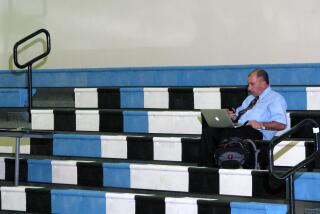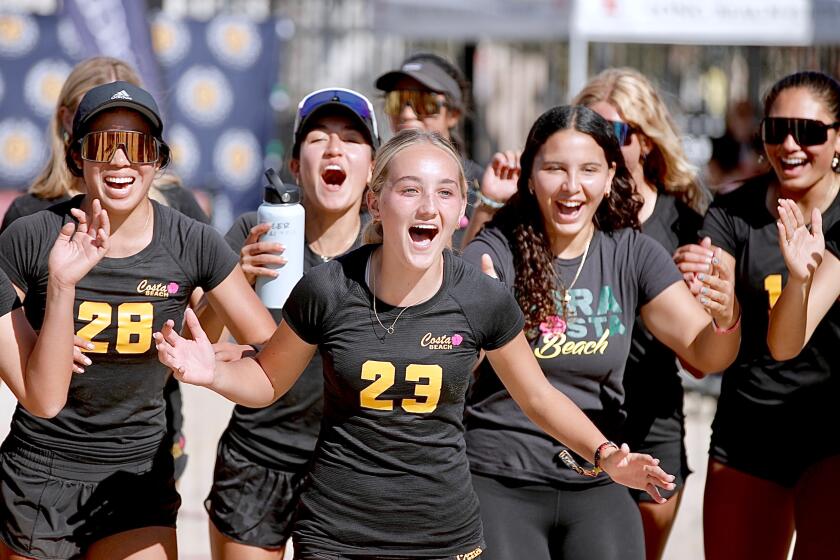Express Purpose
- Share via
Steve Young will ride in a parade today through Canton, Ohio, as one of four new enshrinees in the Pro Football Hall of Fame.
Twenty years ago, Young had trouble finagling a bus ride through Los Angeles.
Young was the $42-million quarterback of the Los Angeles Express at the time, a shining star in the fast-fading United States Football League. No one knew exactly when the league would go belly-up, but few were surprised when it did.
It was 1985, a decade before Young would direct the San Francisco 49ers to their fifth Super Bowl title, back when L.A. had three professional football teams. Embarrassed that just a few thousand spectators rattled around the Coliseum to watch the Express play, team executives decided to schedule their June 15 home game against the Arizona Outlaws at Pierce College. It turned out to be the team’s final home game.
And what a memorable experience it was. Shepard Stadium, roughly the size of a typical high school venue, was expanded for the game from 5,500 to 15,000 seats, yet the place still had a small-time feel. Divots in the turf were filled with green sand, the scoreboard was so faint that officials had to keep yelling out how much time was left, and the place was so quiet that Young had to whisper in the huddle so the defense wouldn’t hear him.
But the game wasn’t the strangest part of the experience. Getting to the game was.
“We got on the bus, and the driver demanded to be paid before we left,” Young recalled. “He just said, ‘Cash only.’ We told him, ‘Hey, we’re just football players. We don’t have any money.’ I’m sure a few of the guys wouldn’t have minded just skipping the game.”
Instead, the trainer, who had just gotten paid, went to the bank and withdrew the necessary cash -- roughly $800 -- to make the bus trip from the team’s Manhattan Beach headquarters to Woodland Hills.
“There were no locker rooms we could use,” Young said. “So we wound up doing our postgame interviews out in the parking lot in the bus fumes. It was like we were back in high school.”
The talent on the Express was anything but rinky-dink. Several Express players went on to have successful NFL careers, among them Pro Bowl players Gary Zimmerman, Kevin Mack and Mel Gray. Then there was Young, who began his NFL career with the Tampa Bay Buccaneers before moving on to San Francisco, where he eventually replaced Joe Montana.
Landing Young, the nation’s best college quarterback in his final season at BYU and runner-up in Heisman Trophy voting, was a coup for the USFL, whose founders thought it essential to build strong franchises in New York and Los Angeles. The New Jersey Generals already had running back Herschel Walker, and Young -- scrambling on the field and dashing off it -- seemed an ideal choice.
The NFL was calling, too. Young had a chance to be the No. 1 pick, but he would have gone to the Cincinnati Bengals, who already had Ken Anderson. After a 22-hour negotiating session with Don Klosterman, general manager of the Express, Young’s agent, Leigh Steinberg, called Bengal owner Mike Brown and gave him the chance to match the USFL’s astronomical offer.
“I asked him, ‘Mike, are you interested in matching?’ ” Steinberg recalled. “And he said, ‘Yes, if we find an oil field under Spinney Field [the Bengals’ practice facility].’ ”
Steinberg said Young was almost embarrassed by the $42-million contract, and, shortly after signing, didn’t want to accept his first $4-million bonus check.
“Just before the press conference, he handed me the check and said, ‘I don’t want it,’ ” said Steinberg, who later discovered Young had several crumpled checks in his sock drawer, among them one for $1 million.
Young never bought a new car; he drove one that was more than 10 years old.
He also had roommates living with him in his Manhattan Beach apartment.
“He never adjusted his lifestyle,” Steinberg said.
Young did collect most of the $42 million, however, all but the amount he paid to buy out the final two years of his contract -- enabling him to jump to the NFL in 1985 -- and the final two years of his Express salary.
After the team’s owner J. William Oldenberg went broke, the USFL honored the rest of Young’s deal.
In some ways, the USFL had a lot to offer. Young’s counterpart in that memorable home finale at Pierce College? Arizona quarterback Doug Williams, who, like Young, went on to become most valuable player of a Super Bowl.
“The field was a little bumpy, but I wasn’t disappointed or bitter,” Williams told The Times in 1995. “We knew what we were up against. We had a league we were trying to sell. The bottom line is we were all getting paid to play. We were still professionals.”
For Young, life as a professional started in L.A. with a league that had big dreams and, especially in the final season, a very small pocketbook.
“We practiced at an elementary school,” Young said, “and we had to pay the next-door neighbor to borrow his lawnmower so we could cut the grass on the practice field.”
There was no money for adhesive tape. Players had to find their own housing for training camp -- receiver Jojo Townsell’s mom let four of them stay at her place -- and, by the end of the season, the Express wasn’t replacing injured players. That led to Young’s playing running back for part of one road game.
“It was the only time I can remember being in a huddle when I wasn’t the quarterback,” he said.
Then there was the time, back when the team was traveling on chartered planes, when a truck backed into the jet on the tarmac, punching a hole in the skin of the plane.
“Don Klosterman starts telling us, ‘Men, I flew in World War II, and someone shot a hole in our engine once. We were fine,’ ” Young said. “We didn’t even stick around for the end of his speech. We were all off the plane at that point.”
Bizarre as his USFL experience was, Young wouldn’t trade the memories. He learned under coach John Hadl, the former star quarterback of the L.A. Rams and San Diego Chargers, and soaked in the knowledge of legendary coach Sid Gillman, the father of the modern passing game, who was an assistant coach for the Express. Running the team was Klosterman, a fixture in the NFL for decades.
“We were,” Young said, “the best-kept secret in Los Angeles.”
*
(BEGIN TEXT OF INFOBOX)
Forever Young
A look at Steve Young’s statistics during his pro football career with the USFL’s L.A. Express (1984-85) and the NFL’s Tampa Bay Buccaneers (1985-86) and San Francisco 49ers (1987-99):
*--* Passing Rushing Year G C Att Pct Yds TD Int Att Yds TD 1984* 12 179 310 57.7 2,361 10 9 79 515 7 1985* 13 137 250 54.8 1,741 6 13 56 368 2 1985 5 72 138 52.2 935 3 8 40 233 1 1986 14 195 363 53.7 2,282 8 13 74 425 5 1987 8 37 69 53.6 570 10 0 26 190 1 1988 11 54 101 53.5 680 3 3 27 184 1 1989 10 64 92 69.6 1,001 8 3 38 126 2 1990 6 38 62 61.3 427 2 0 15 159 0 1991 11 180 279 64.5 2,517 17 8 66 415 4 1992 16 268 402 66.7 3,465 25 7 76 537 4 1993 16 314 462 68.0 4,023 29 16 69 407 2 1994 16 324 461 70.3 3,969 35 10 58 293 7 1995 11 299 447 66.9 3,200 20 11 50 250 3 1996 12 214 316 67.7 2,410 14 6 52 310 4 1997 15 241 356 67.7 3,029 19 6 50 199 3 1998 15 322 517 62.3 4,170 36 12 70 454 6 1999 3 45 84 53.6 446 3 4 11 57 0 Totals 194 2983 4709 63.3 37,226 248 129 857 5,122 52 * Express statistics
*--*
*
Profootballreference.com
More to Read
Go beyond the scoreboard
Get the latest on L.A.'s teams in the daily Sports Report newsletter.
You may occasionally receive promotional content from the Los Angeles Times.











